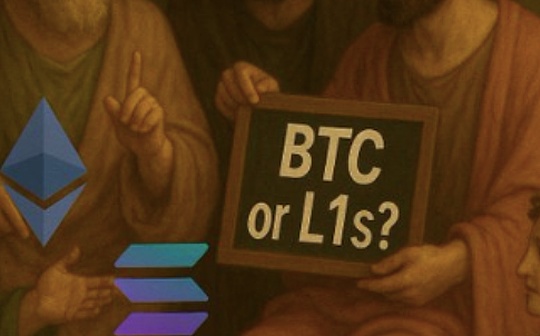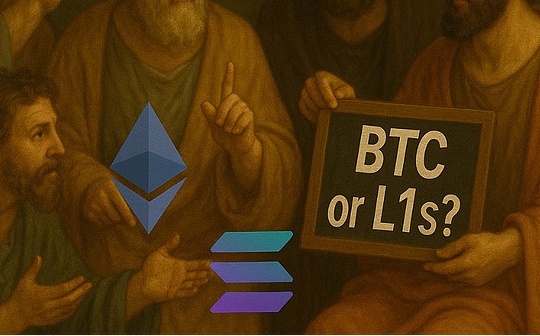
author:Zeke & Amp; AC-Core, YBB Capital Research, Web3Caff Research institution
It is impossible for blockchain to triangle dilemma (that is, in terms of safety, expansion, decentralization, and difficult to balance). In the past, it has been a difficult gap in the industry. With the comprehensive upgrade of Ethereum around the Rollup solution, the triangle dilemma is expanded.The problem is effectively solved now.When everyone thinks that the public chain war is about to come to an end and turn to the Layer2 war, Celestia is born.This project that is accidentally promoted by Vitalik Buterin in the overall modularization plan of Ethereum has become a new “Ethereum killer”, and its definition of modular standards will force Ethereum into a new dispute.
This report will start from the beginning of the data availability layer (DA). The modular interpretation will be used as a major solution recognized by the DA track market.Analysis, comprehensively interpret the rise and development of the DA track.
Table of contents
>
The beginning of DA narrative: the origin of modularity
The birth of the modular blockchain originated from two white papers. In 2018, Mustafa Albasan and Vitalik Buterin jointly wrote a paper called “Data Availability Sampling and Fraud Proofs”.This paper describes a system that allows light clients to receive and verify the design of fraud from the entire node, as well as the design of the data availability sampling protocol to reduce the balance between the capacity and security on the chain, so as not to sacrifice safety and decentralization.Under the premise, solve the scalability of the blockchain.
Then in 2019, Mustafa Albasan introduced a new architecture in detail when writing the white paper “Lazy Ledger”. The blockchain was only used to sort and ensure the availability of transaction data, and it was not responsible for the execution and verification of the transaction.The purpose of this architecture is to solve the scalability of the existing blockchain system.He called this “smart contract client” at the time.The execution of the smart contract is executed on this client through another execution layer, which is the prototype of Celestia (the first modular DA -layer project).
With the advent of ROLLUP, this idea is more certain. The logic is to execute smart contracts for the departure, and then converge the result to prove to be uploaded to the execution layer of the “client”.By reflecting the architecture of the blockchain and new capacity expansion technology, Celestia was born, and defined a new paradigm blockchain, that is, today’s “modular blockchain”.
What is modular blockchain
The modular blockchain aims to solve the triangle problem that has been in confusion in the industry for many years through abstract, peeling, and re -combination.Simply put, it is to decouple the main function of the single chain into a multi -layer and focus on the implementation of a Lejo -type capacity expansion scheme with a single or part of the functional layer.In a broad sense, the most basic function of a single chain can be abstracted into the following four functional layers:
-
Data-Availability Layer: Data availability layer (hereinafter referred to as DA layer) is responsible for ensuring that data in the network can be accessed and verified in the modular blockchain.It usually includes data storage, transmission, and verification functions to ensure the transparency and trust of the blockchain network.In the modular architecture, as the storage, verification and confirmation of all original transactions in the execution level.At present, the most representative DA projects include CELESTIA, Avail, EIGENDA, etc. In addition, various single public chains such as Ethereum and Solana can also carry DA demand (Bitcoin is passive bearing, due to non -Tu spiritual completion.At present, there is no good solution verification for traditional Rollup, but the mining of BTC’s capacity is very fast);
-
Consensus layer: Responsible for the protocol between nodes to achieve consistency of data and transactions in the network.It verifies the transaction and creates a new block through specific consensus algorithms, such as workingload (POW) or equity certificate (POS).Like the public chain, most of the DA projects must also have their own consensus layer. Without considering the implementation of transactions, the design logic of its consensus is often a light node method that adheres to the very low operating hardware requirements and simple verification;
-
Execution layer: The execution layer is mainly responsible for handling transactions and execution of smart contracts.It includes transaction verification, execution and state update.We are familiar with Layer2 (can also be called rollup, but for the use of the main chain DA project, the Ethereum community is generally called layer2, this title has some orthodox meaning) projects, such as Arbitrum, Optimism, ZKSYNC, all belongThe modular blockchain with execution layers is essentially a centralized blockchain, but the method of verifying the correctness of transaction through the main chain can inherit the security of the main chain;
-
Settlement layer: Responsible for completing the final settlement of the transaction to ensure that the transfer of assets and records is permanently stored on the blockchain, and the final state of the blockchain determines the blockchain.The modular settlement layer is mainly to verify the effective proof and status data of the Rollup. The well -known projects in the settlement layer include Dymension, CEVMOS, etc.
In fact, according to this definition, in the early history of the blockchain, there are also “modular pioneers” born of Bitcoin, such as lightning networks, and side chains.However, due to the complete characteristics of Bitcoin non -Turing, the progress of these capacity expansion schemes is either extremely slow, or there are various defects, and they are not widely used.Therefore, the early blockchain has always been renamed a large -scale innovation through a fully reconstruction of the underlying framework.paradox.The first two are heavy, slow, stupid, and as the core chain of the most core blockchain, any major upgrade needs to consider how to maintain orthodoxity and security.The Ethereum killers are limited to the triangle no matter how they improve them.
In order to solve this problem, the scheme around Rollup was put on the agenda by Vitalik Buterin.Thanks to the increasing maturity of fraud proof and zero -knowledge proof (validity proof), continuing the idea of the Lightning network and side chain, and the implementation of the implementation of the implementation layer on Ethereum has gradually become a reality.The final game is set as a path of dilatation that is upgraded around the ROLLUP upgrade.So is the upgrade method with rollup as the core, can it really surpass the past expansion and become the endgame of the public chain war?
Single blockchain VS modular blockchain
Before modularization, we experienced the public chain war. Ethereum became the leader of the leading blockchain with his doubtful innovation advantages of his ecological mother.When many people think that the era of the public chain will be ended again by Ethereum leading Rollup, Solana has rejected it again with its own smooth integrated experience and a very cohesive community.Intersection
Let’s talk about the personal conclusion that the modularity will win, but there are also a lot of modular defects.We think here two points, 1. 1. Large -scale adoption; 2. Comparison of safety and fluency.
Start from the future of the public chain
First of all, we imagine what is the ideal public chain that is in line with large -scale use. Under decentralization, it provides millions or even hundreds of millions of users with high TPS, ultra -low GAS, and smooth commercial grade services.This cannot be achieved under the single chain architecture, and even some of the strongest public chains today.Because the blockchain is essentially a replicable certain state machine, whenever the network status is updated, it is necessary to synchronize through all nodes, copy and process the same data to ensure the consistency of the distributed system to obtain decentralization and security.sex.This framework is obviously naturally inconsistent with large -scale adoption. There are four reasons:
-
Low performance, the performance of the blockchain is equivalent to the level of a single node;
-
A large number of online activities will cause a high GAS Fee;
-
The data of the number of days will cause the state explosion, resulting in increased node hardware requirements, especially the disk space needs permanent records, which is contrary to the premise of decentralization;
-
The upgrade of public chain is extremely difficult under this framework.
-
Data storage on the blockchain: All transaction data are stored directly in the blockchain;
-
Node verification: All nodes can be accessed and verified data;
-
High security: Since all data is on the blockchain, any node can verify the integrity and effectiveness of the data.
-
High transparency: All data can be visible public, easy to audit;
-
Decentralization: All nodes can access complete data to ensure the decentralization and security of the system.
-
Poor expansion: Large amount of data, leading to the heavy burden of storage and processing of the blockchain, affecting performance and scalability;
-
High cost: The cost of storage and transmission of a large amount of data is high, especially in the case of high transaction volume.
-
Data storage is under the chain: Most transaction data is stored under the chain, only stored on the chain and verified data;
-
Light node verification: The light node only needs to verify the data on the chain (such as the hash value), and there is no need to store complete data.
-
Good expansion: reduce the amount of data on the chain, improve the processing ability and scalability of the system;
-
Low cost: Reduced the cost of data storage and transmission, suitable for large -scale applications.
-
Storage under security dependencies: The integrity and availability of the data depend on the security and credibility of the storage under the chain;
-
High complexity: needed additional mechanisms to ensure the availability and verification of data under the chain, and increase the complexity of the system.
-
BLOB storage contract: a contract that stores any data.
-
Light client: No trusted client outside the chain, you can easily access transactions and receipt data.
-
RPC client: publish data Blob client to Near protocol.
-
Security: Inherit the security of the Near network
And the modular chain, especially when ROLLUP is crazy (L2, L3, L4 …), its performance and costs can be infinitely close to the centralized server.Therefore, the blockchain needs to go to the mainstream consideration. Modularization is the only way out. In addition, in terms of combination, Rollup can also build different architectures to adapt to different virtual machines, including MOVE VM, SVM, and even evenIt is an upgraded version of ICP (that is, AR’s hyperserto computer AO).Judging from the current modularization of INFRA, most developers are the same for future choices.
From the perspective of the user
From the perspective of performance, cost, and combined, it is indeed a huge victory of modularity.However, from the perspective of security and fluency, modularization is far less than high -performance public chains such as Solana.This conclusion may make people feel a little confused. Why is ROLLUP very high performance?If rollup is based on Ethereum, which is only second only to Bitcoin, is not safe?This actually involves the problem of asset circulation and modularity. First of all, in a huge modular system, there may be thousands of modular combination methods. Rollup currently has hundreds of.There are also many, as well as the settlement layer. After refinement, there are more segmented modular function layers such as liquidity layer and computing power layer.Future fragmentation will continue to intensify, but problems with any layer may drive the collapse of the entire “Lego Block Tower”.[1]
On the other hand, the transmission of assets and information in the modular system requires the bridge. First of all, the bridge is very fragile and centralized.Users need to operate between each chain first to transfer the assets with various third -party bridges. In addition to waiting for a long time, there may be large hidden safety hazards, and GAS will even appear.In the future, there will be no use of ETH as a GAS Fee project). The target chain is extremely liquid and can be entered and cannot be produced.These situations will never appear on high -performance public chains. The entire system circulation of single -chip chain, especially the parallelized public chain, is extremely smooth and far more secure than frequent cross -chain. The only problem that is criticized is often not decentralized.
Therefore, the modularization is not perfect, but it is indeed the only way out in the current stage.Finally, simply summarize that modularization is likely to be the only way for all public chains to the future. As long as this is recalling the various stuck stuttering of Solana caused by the grand occasion of Stepn, it is not difficult to understand.It is also difficult to carry complex applications and large -scale applications in single chain performance. In the future, it is more likely to put large asset transactions, pledge, and NFT bearer on the main chain.Rollup is used without higher performance, and the lack of modular natural unsafe and interoperability will be made up by the full -chain protocol such as Layerero and Wormhole (this is why VC is under the pressure of billions of valuations, Fully bet on this track), and finally it will really enter the web3 when the Infra construction is perfect.
The dilemma of application chain and long -tail chain
To this day, the Layer2 project has been flowing on Ethereum, and the concept of the modular execution layer has penetrated into multiple corners of the blockchain. A large number of Rollup demand for DA is naturally increasing.Especially for the upcoming all -chain games and application chains such as AI and DEFI, the throughput and cost of the DA layer are the real “performance bottleneck”.In addition to the application chain, the long tail chain at the rear can not afford too high costs, but because the horizontal sharding expansion of Ethereum needs to be completed in three major upgrades (the current Kankun upgrade has completed the first step), and the progress is slow, and the progress is slow.In these two aspects, it does not meet the needs of this kind of rollup, so escape Ethereum and find a DA solution that truly meets the needs will be inevitable.
Modular drawing data availability (DA) layer
When it comes to the problem of cost reduction, the current low -cost DA solution of non -main chain can be divided into three categories: modular DA, putting verification on Ethereum L2 to become L3 and inheriting orthodoxy and linked verification (Validium, Plasma).However, because the L3 is not yet mature and the Lego bricks are added, the risks will increase. The verification under the chain is rejected by the Ethereum community and the problem of being criticized. It is currently a niche choice.The modular DA project with DA as the core concept has lower costs, easier to update and targeted architecture, and higher throughput. It is often the mainstream choice of non -main chain DA solution.As far as the most representative Celestia is concerned, its throughput was about 44.6-67 times the Ethereum CALLDATA before upgrading.According to the GAS Fee data calculated based on Manta Network, the GAS FEE data calculated based on Manta Network, saving about $ 2 million in costs (data source CELESTIA Labs CRO interviews in March this year).
After the upgrade of Cancan, Ethereum has reduced the DA cost by more than 10 times through Blob Space. Many people think that the threat of Celestia no longer exists.In fact, according to the calculation data of DataLenses, there are still more than 100 times the cost gap between the two.So before Ethereum completed the entire shard upgrade, the modular DA can still seize this part of the market, and in addition to the modular DA, there are many public chains and related projects that are joining this rental market.
Rent market
In fact, the ultimate goal of Ethereum can also be called “blockchain Wanda”. After all, the charterer is much easier than self -employment. If you keep some high -quality self -employment, you can rent most of the “business positions” rental.EssenceIn the case of the rest of the execution layer, the functional layer required by the Ethereum is actually similar to the modular DA. In most cases, it also provides the function of DA and consensus.From this perspective, in fact, the ultimate goals of the two are the same. Except for the lack of moats such as Celestia and other DA projects, they have great advantages in other respects.This will undoubtedly touch the big cake of Ethereum monopolized DA. It is precisely because the core of the Ethereum community always emphasizes the orthodoxy of the chain to exclude the L2 project of the non -main chain DA, so even the households with the same door are required to be the same door.Being in the Ethereum community.
However, the interesting thing is that the development of the DA market has not been affected by the Ethereum community.Judging from the status quo of the entire DA market, there are more and more DA projects born according to demand.In the future, in addition to the modular DA, it is also on the BTC that can carry ROLLUP. The degree of decentralization is being excavated and verified and expanded.DA.Modularity, which is derived from Ethereum’s expansion narrative, is constantly being eaten by other projects. The past public chain war will evolve into multi -level and multi -faceted war wars.
Comparison of Ethereum native data usability (DA) and four DA solutions cost structure comparison
>
The current status and analysis of the four major solutions of the DA track
As described above, data availability refers to the ability of all nodes to access and obtain all historical data generated by systems in the blockchain network.In the process to ensure that the transaction is correctly verified by all verifications, all nodes need to obtain complete data.
Data Availability in the blockchain refers to the access and verifiable that the data in the blockchain is required when the data in the blockchain is required.Data usability problem is a key challenge in the scalability of the blockchain, especially in sharding and Layer 2 solutions.There are two main solutions: chain solutions and linked solutions.They each have advantages and disadvantages.
Chain solution
The solution on the chain refers to all data stored on the blockchain to ensure the availability and integrity of the data.The main characteristics and advantages and disadvantages of this method are as follows:
feature:
advantage:
shortcoming:
Chain solution
Under the chain solution, the data usability is available by storing most of the data under the chain, and only the necessary verification data (such as the hash value) on the blockchain to ensure the availability of data.Common chain solutions include data availability layers (such as Data Availability Layer), and data availability committees.
feature:
advantage:
shortcoming:
Overall, the choice of chain solutions and chain solutions on Data Availability depends on the needs of specific applications.The solution on the chain (data is stored directly on the blockchain): It is more suitable for application scenarios that are extremely high in security and decentralization, but less focused on scalability application scenarios.The linked solution (transfer data storage and verification from the blockchain to the chain such as: side chain, status channel, zero knowledge proof, data availability certificate, etc.): more suitable for large -scale applications that require high scalability and low -cost application, But need to make a certain amount of weighing in terms of safety and complexity.Modern blockchain technology often combines two methods, and balances security, decentralization and scalability through hybrid mode (such as the fragment technology in Ethereum 2.0).
EIGENDA: Serving ROLLUP data availability
>
EIGENDA aims to provide Rollups with innovative DA solutions. By connecting Ethereum pledges and verificationrs to improve safety, the goal of improving throughput and reducing costs.Eigenlayer’s shared safety system will adopt a multi -node method to ensure decentralization.
By providing decentralized data usability (DA) service, it provides Rollup with a highly efficient, low -cost and secure data storage and verification solution.Specifically, the availability of the EIGENDA service ROLLUP data is as follows:
1. Use RestAKing function
EIGENDA is built on Eigenlayer and uses Eigenlayer’s re -pledge function.RestAKing allows Ethereum pledges to entrust ETH pledged to EIGENDA to provide guarantee for data availability services.This mechanism not only increases the flexibility of pledge, but also enhances the security of the system through the participation of pledges.
2. Data release and storage
Rollup can publish its transaction data to EIGENDA instead of directly stored on the main chain of Ethereum.EIGENDA ensures that these data are available and verified through distributed storage and verification mechanisms.This method reduces the storage and calculation burden of the main chain and reduces transaction costs.
3. Node verification
In the EIGENDA system, node operators are responsible for performing data verification tasks.The pledges entrust them to these node operators, and node operators obtain service fees through data verification.Node operators verify and store data submitted by Rollup to ensure the integrity and availability of the data.
4. Active verification service (AVS)
EIGENDA, as the first active verification service (AVS) on Eigenlayer, actively participated in data verification and maintenance.Through this mechanism, EIGENDA provides an efficient data availability service that allows Rollup to store and verify its data efficiently.
5. Enhance safety and throughput
With the increase of pledge on EIGENDA and the development of nodes and protocols participating, the overall safety and transaction throughput of the system will be further increased.The participation of pledges and node operators not only improves the security of data, but also improves systematic scalability and processing capabilities through distributed storage and verification mechanisms.
6. Integration and interoperability
With official public information, EIGENDA has integrated a variety of Layer 2 schemes, including Mantle (Mantle from L1 to Ethereum L2), BitDao ecosystem, and its supporting products, provides FLUENT on ZKWASM execution layer, offShore provided MOVE execution layer OFFSHOREAnd OP Stack in Optimism used in the EIGENDA test network.These integration enhance the interoperability of EIGENDA, enable them to serve a variety of different Rollup solutions, and further improve the flexibility and applicability of the system.
Cooperation and potential conflicts between EIGENDA and Ethereum native data usability (DA)
In terms of cooperation, EIGENDA provides specialized decentralized data availability layers, effectively alleviating the burden on the main chain of Ethereum, so that the main chain can focus on other core functions.In addition, EIGENDA uses Eigenlayer’s re -pledge function to enhance the security and credibility of data availability with the resources of the Ethereum pledged.This cooperative relationship not only uses the existing security model of Ethereum, but also provides additional guarantee for EIGENDA.
By integrating the Layer 2 scheme in the Ethereum ecosystem, such as Celo, Mantle, FLUENT, Offshore, and OPTIMISM, EIGENDA has promoted the development of the entire Ethereum ecosystem, providing the popularity and application of Layer 2 solutions to the popularization and application of Layer 2 solutions.Better data availability services.EIGENDA’s technological innovation in decentralized data availability can also be fed back to the Ethereum community to promote Ethereum’s progress in data processing and storage technology.
However, there are potential conflicts between EIGENDA and Ethereum native DA.First of all, the struggle for pledged resources may be a problem. EIGENDA relies on the re -pledge function of Eigenlayer, which means that the pledgers may need to make choices between Ethereum native pledge and EIGENDA pledge. The dispersing of this resource may affect the original Ethereum native to Ethereum nativelyOperation of the pledge mechanism.Secondly, the decentralization of development resources and attention may also lead to conflict. Ethereum developers and communities may need to allocate limited resources and attention between Ethereum native DA solutions and EIGENDA, which will definitely affect the development of Ethereum native DA in Ethereum.process.
In addition, market acceptance may also become a problem. Different projects and developers may choose between Ethereum native DA solutions and EIGENDA. The acceptance and preference of the market’s two solutions may affect its development direction and popularizationdegree.Finally, the differences in the governance mechanism may also lead to conflict.Ethereum native DA and EIGENDA may have different governance mechanisms. This difference may cause conflict during the decision -making process, especially in the issue of changes involving agreement or resource allocation.
Overall, EIGENDA and Ethereum native DA solutions have their own performance in cooperation and conflict.In terms of cooperation, EIGENDA has enhanced the scalability and security of Ethereum through special DA services and promoted the common development of the ecosystem.In terms of conflicts, competition in pledge resources, development resources and market selection may affect the development of the two.How to balance and coordinate the relationship between the two will be an important issue for the continuous development and optimization of the Ethereum ecosystem in the future.
Celestia: Make start independent blockchain simple
>
Celestia’s modular architecture will exist independently on their respective blockchains, allowing optimization and professionalization for specific cases.Any developers who build decentralized applications based on this architecture can enjoy higher security and scalability on the basis of the original blockchain execution layer.In addition, in the modular blockchain of Celestia, data usage sampling can be achieved, so that the node can verify a block with a small sample, and the low -hardware configuration device can also act as nodes (related extension reading see YBB CAPITAL’s previous periodArticle: modular blockchain: new perspective and DA economics of functional disputes).
The logic of simple deployment chain
In the past, a blockchain was deployed to establish an independent consensus mechanism to verify the network and incentive nodes, so the requirements for resources and costs were very high.The Celestia provides complete consensus and security, allowing multiple chains to share the usability (DA) layer of the same data, thereby reducing the trust needs of the chain bridge, and combining the sharing of the open ecosystem of COSMOS and the sharing of Ethereum, therebyIt provides possibilities for the openness and sharing security of multi -chain.
Modular structure
Separation consensus and execution layer:
Celestia separate consensus layers from execution layers, allowing developers to focus on their application logic and smart contracts without processing the underlying consensus mechanism.Consensus and data usability are provided by Celestia, which simplifies the development and deployment of blockchain.
Special data usability layer
Data usability service:
Celestia provides a dedicated data availability layer to ensure that all data is available and verified on the chain.The new blockchain can use this service of Celestia without the need to build and maintain a complex data availability mechanism.This reduces the development time and cost, making it more convenient to start the independent blockchain.
Lightweight client support
Data availability sampling (DAS):
Celestia allows light nodes to verify the availability of data through data availability sampling without downloading and storing data from the entire blockchain.This reduces the hardware requirements of the node, so that more developers can easily start and maintain their blockchain.
Enhanced scalability
High throughput and low cost:
By separating consensus and data usability, Celestia provides higher scalability.Developers can build a high throughput application chain. These chains are published on Celestia to enjoy their efficient data availability and consensus services, thereby achieving higher transaction throughput and lower transaction costs.
Sharing security
Sharing safety model:
The newly launched blockchain can share the security of CELESTIA and use its strong consensus and data availability services.This sharing security model reduces the burden on the establishment of an independent security mechanism for the development of the developer, while improving the safety and reliability of the overall system.
Flexible development tools
Development tools and document support:
Celestia provides a series of development tools, SDKs and detailed documents to help developers get started and create their own independent blockchain.These tools and resources simplify the development process, making the start and deployment new chain more intuitive and convenient.
Celestia overall through modular architecture, special data availability layer, lightweight client support, enhanced scalability, sharing security, and rich development tools, Celestia greatly reduces the complexity of launching independent blockchain.Developers can focus on innovation and application development without worrying about the complex realization of underlying infrastructure.
Nearda: Turn the network in parallel into multiple slices
>
According to Near official Medium description [2], Near Da provides developers with a solution for opening out of the box, enabling the scroll buildersEssenceThe Pagoda engineering team has built three important open source components, which can be integrated at any OP Stack, Polygon CDK or Arbitrum Nitro Rollups at any time::
The Near protocol adopts its unique design and technology to make the network in parallel into multiple shards, thereby achieving efficient scalability and performance.
NightShade design
S sharing consensus:
The Near protocol adopts a sharding design called “NightShade”, and each shard maintains its independent state and transaction collection.Sharing a overall blockchain structure, but the transaction of each shard is logically processed independently.Each shard has its own block producer and verification person to ensure the parallel processing of the transaction.
Status shard:
The sharding in the night shadow design is state sharding, which means that each piece only maintains part of its global state.In this way, the computing and storage burden on the entire network can be scattered into each piece, and a single node can be avoided as a performance bottleneck.
2. Dynamic shard
Dynamic shard management:
The NEAR protocol supports dynamic shard management, which means that the number of shards can be dynamically adjusted according to network needs.With the increase of network loads, more shards can be added to divide the load, and vice versa.This dynamic adjustment ability ensures the efficient operation of the network and the reasonable use of resources.
3. Cross-size Communication
Asynchronous cross -film communication:
Near uses asynchronous cross -chip communication mechanism to allow efficient information exchange between shards.Each piece can interact with other shards while handling its own transactions.This design ensures that the communication between shards will not become a bottleneck, while maintaining the consistency of the entire network.
Data usability guarantee:
In order to ensure the security of cross -shard transactions and the availability of data, Near uses a mechanism called “Fishermen”.These Fishermen nodes are responsible for monitoring and verifying the correctness of cross -chip communication to ensure the integrity and reliability of the data between the seabil.
4. The role of the verification
Elberry verification person:
In the Near network, each shard has its own verification, and these verifiedrs are responsible for the verification and consensus of the in -fraction transactions.This design ensures the independence and parallel processing capabilities of shards.
Random distribution and rotation:
Verifications rotate between different shards by random distribution and regular rotation.This mechanism improves the security and anti -review capabilities of the network because an attacker is difficult to predict and control the verification of specific shards.
5. Scribe treatment and pledge
Pledge and governance:
The Near protocol adopts the pledge mechanism, and the pledged person has locked the token to participate in network governance and sharding verification.The pledges are distributed between different shards to ensure that each shard has sufficient verifications to participate in consensus.This distributed pledge mechanism improves the security and stability of the network.
Avail: “Trinity” simplify the rollup experience
>
1. Avail DA (Data Availability)
Data usability layer:
Avail Da provides a special data availability layer to ensure that all published data are available and verified on the chain.Rollup relies on this layer to ensure that status transfer and proof prove that the data required for generation is available.Avail DA’s data availability layer reduces the complexity of data storage and processing by reducing the dependence on the main chain of Ethereum, enabling Rollup to run more efficiently.
Data sampling technology:
It uses Grandpa + Babe consensus algorithm to determine the availability of the entire data set through data sampling technology (DAS), Avail Da allows light nodes to determine the availability of the entire data set by verifying a small amount of data clips.This method improves the efficiency and reliability of data verification, allowing Rollup to access the required data quickly and securely.
2. Avail Nexus
Modular architecture:
Avail Nexus is a modular framework to separate data availability and execution layer.Through this separation and use Avail DA as a trust root, developers can independently build ROLLUP independently to focus on application logic and state transfer without worrying about the underlying data availability problem.Nexus provides standardized interfaces and tools, enabling seamless collaboration between different modules.
Easy to integrate:
Nexus provides easy -to -integrate development tools and APIs, allowing developers to quickly integrate Avail DA’s function into their Rollup solutions.In this way, the process of development and deployment of Rollup becomes more intuitive and efficient.
3. Avail Fusion
Cross -chain interoperability:
Avail Fusion provides cross -chain compatibility and supports interoperability with multiple blockchain platforms.This cross -chain capacity allows developers to easily migrate and deploy their Rollup between different blockchains, which improves Rollup’s portability and application range.
Sharing security:
Through Fusion, multiple ROLLUP can share the data availability layer provided by Avail, thereby using consensus and security mechanisms to reduce the needs of each rollup separate security mechanism, but Fusion is still in the development stage.
EIGENDA, Celestia, Nearda, and Avail analysis comparison
>
>
Summarize
Looking forward to the future, Ethereum’s native data usability (DA) and major solutions will continue to innovate, break through the bottleneck of technical bottlenecks, and bring unprecedented scalability and efficiency to the blockchain field.From a market and technical perspective, Ethereum’s native DA introduced Proto-Danksharding through the upgrade of Cannon, greatly improving data availability and scalability, reducing transaction costs, and gradually achieving a modular structure.EIGENDA focuses on efficient ZK-Rollups, relying on the main network of Ethereum, technically optimizing data processing and reducing costs.Celestia is positioned as an innovative modular blockchain in the market. It enhances flexibility and scalability by separating consensus and data availability layers.Nearda uses sliced technology to improve data processing efficiency and is suitable for high -performance applications.Avail provides a dedicated data availability layer, optimizing data verification and storage, and improving overall performance.
Modularity and data usability will have a profound impact on the future development of Ethereum, but before large -scale implementation, many technical challenges need to be resolved.For example, issues such as cross -chip and cross -rollup and the efficiency of data verification mechanisms need to be solved urgently.In addition, while ensuring large -scale expansion, the security and decentralization of data are still the key.How to seamlessly integrate with the existing Ethereum ecosystem to ensure the compatibility of smart contracts, DAPPs and infrastructure, avoid fragmented by technological upgrades that lead to fragmentation of the ecosystem, are also important tasks for future development.
Reference
[1] Single -film VS Modification: Who is the future of the blockchain?-Techflow deep tide, https://www.techflowpost.com/article/detail_14160.html
[2] Why do you provide Near data?-Medium, https://medium.com/nearprotocol/why-data-availability
Disclaimer: This report is written by Web3caff Research. The information included is for reference only. It does not constitute any prediction or investment proposal, proposal or offer. Investors should not rely on such information to purchase, sell any securities, cryptocurrencies, or adopt any investment strategy.EssenceThe terms and expressions used in the report are designed to help understand the movement of the industry, promote the responsible development of the Web3, including the blockchain industry, and should not be explained as a clear legal point of view or the viewpoint of Web3caff Research.The view in the report only reflects the author’s personal opinion as of the date, has nothing to do with the position of Web3caff Research, and may change the situation.The information and views contained in this report come from Web3caff Research that reliable and non -proprietary sources believe that it does not necessarily cover all data and does not guarantee its accuracy.Therefore, Web3caff Research does not guarantee any form of accuracy and reliability, and does not assume the responsibility of errors and omissions generated in any other way (including the responsibility of anyone due to negligence).This report may contain “forward -looking” information. This kind of information may include predictions and forecasts, and this article does not constitute a guarantee for any prediction.Whether to rely on the information contained in this report is completely determined by the reader.This report is for reference only, and does not constitute an investment proposal, proposal or offer to purchase or sell any securities, cryptocurrencies or adopt any investment strategy, and please strictly abide by the relevant laws and regulations in your country or region.







